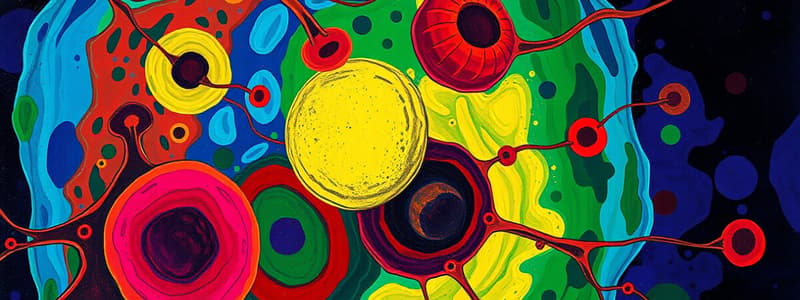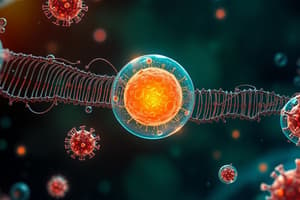Podcast
Questions and Answers
Where did cells originate?
Where did cells originate?
All organisms share a most recent common ancestor called the last universal common ancestor (LUCA).
What did LUCA contain?
What did LUCA contain?
Organic molecules and RNA-like materials for informational and catalytic functions.
What are the structures that all living cells share? (Select all that apply)
What are the structures that all living cells share? (Select all that apply)
- Mitochondria
- Cytosol (correct)
- Ribosomes (correct)
- Cell membrane (correct)
What is the control center of the cell?
What is the control center of the cell?
What does the nuclear envelope do?
What does the nuclear envelope do?
What is the function of the nucleolus?
What is the function of the nucleolus?
What is chromatin?
What is chromatin?
Flashcards are hidden until you start studying
Study Notes
Origin of Cells
- All organisms share a common ancestor known as the last universal common ancestor (LUCA).
- LUCA is believed to have formed approximately 3.6 to 3.8 billion years ago and was a single-celled organism.
- LUCA contained essential organic molecules and RNA-like materials that served both informational and catalytic roles.
- Over time, evolutionary processes led populations of LUCA to develop DNA and more complex molecular structures.
Cell Organelles
- Cell organelles, referred to as "little organs," are separated membranous compartments within living organisms' cells.
- These organelles perform distinct functions essential for cellular operation and overall organism health.
Cell Structure
- All living organisms possess cells featuring four fundamental structures:
- Cell membrane, providing a protective barrier.
- Cytosol, the fluid component where cellular processes occur.
- DNA, serving as the genetic material that dictates cellular functions.
- Ribosomes, responsible for protein synthesis.
Control Center of the Cell
Nucleus
- The nucleus functions as the control center, housing the genetic information required for cell functioning.
- It regulates cell activities and the expression of genes.
Parts of the Nucleus
- Nuclear Envelope: A double-membrane structure that encloses the nucleus, separating it from the cytoplasm.
- Nucleolus: A sub-structure within the nucleus responsible for synthesizing ribosomal RNA (rRNA) and assembling ribosomes.
- Chromatin: A complex of DNA and proteins that packages DNA into dense structures, facilitating efficient organization and regulation of genetic material.
Studying That Suits You
Use AI to generate personalized quizzes and flashcards to suit your learning preferences.




